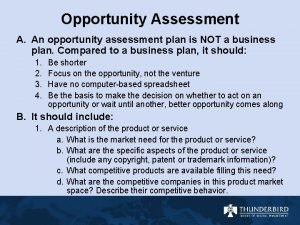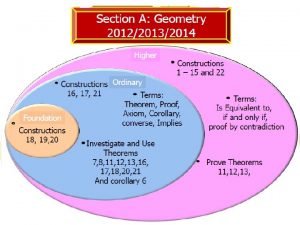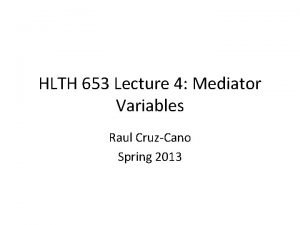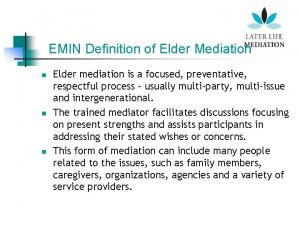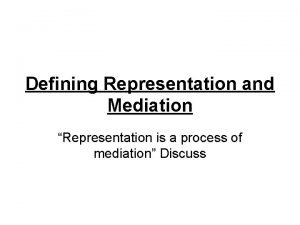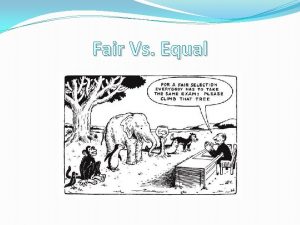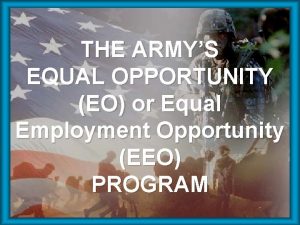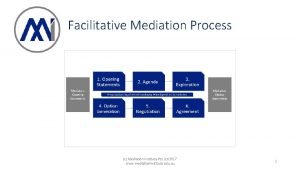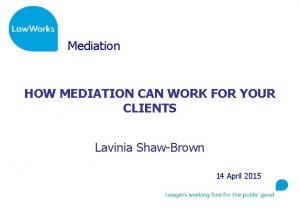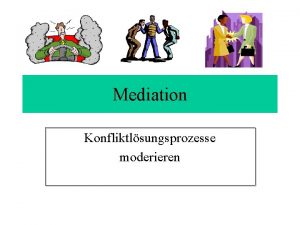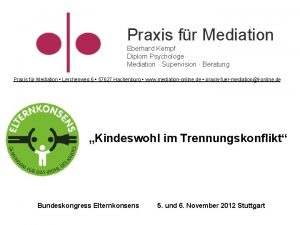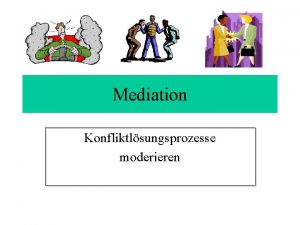Equal Opportunity Mediation Equal Opportunity its the Law

























- Slides: 25

Equal Opportunity & Mediation

Equal Opportunity, it’s the Law When an entity accepts financial assistance, either directly or indirectly (includes s successor, assignee, or transferee), from the Workforce Innovation and Opportunity Act (WIOA), it has the ability to comply to and will continue to comply with the following laws: • Section 188 of WIOA, which prohibits discrimination against all individuals in the United States on the basis of race, color, religion, sex (including pregnancy, childbirth, and related medical conditions, transgender status, and gender identity), national origin (including limited English proficiency), age, disability, or political affiliation or belief, or against beneficiaries on the basis of either citizenship status or participation in any WIOA Title Ifinancially assisted program or activity; • Title VI of the Civil Rights Act of 1964, as amended, which prohibits discrimination on the bases of race, color and national origin; • Section 504 of the Rehabilitation Act of 1973, as amended, which prohibits discrimination against qualified individuals with disabilities; • The Age Discrimination Act of 1975, as amended, which prohibits discrimination on the basis of age; and • Title IX of the Education Amendments of 1972, as amended, which prohibits discrimination on the basis of sex in educational programs. • 29 C. F. R. Part 38, implements WIOA Section 188

What is Mediation?

What is Mediation? Mediation provides a neutral and confidential setting where both parties can openly discuss information about the underlying dispute. Mediation is essentially a negotiation facilitated by a neutral third party.

Mediator Role The mediator: • Facilitates the resolution of the parties' disputes by supervising the exchange of information and the bargaining process. • Helps the parties find common ground and deal with unrealistic expectations. • Interpret concerns, relay information, frame issues, and define the problem(s). • Offers creative solutions.

Understand & Explain your Role If you are the Equal Opportunity Officer, explain your role to the participant. If you are frontline staff, explain that part of your job is also to ensure equal access to programs and benefits.

Behind the Curtain Interests: An underlying concern or need of a person Position: a stance one takes on a particular issue

Listening & Mediation Goals: • Acquire information • Build trust • De-escalate • Translating • Increase clarity about goals, interests, and concerns

Listening & Mediation (cont. ) Challenges: • Impartiality • Parallel processing • Managing interruptions • Managing your reaction

Listening & Mediation (cont. ) Body language: • Appropriate eye contact • Body movement, e. g. nodding • Facial expressions • Tone of voice

Active Listening

Active Listening & Emotions Understand recognize emotions • What is producing this emotion? • Are emotions spilling over from on issue to another? • Remember why people are utilizing services

Active Listening & Emotions Pay attention to core interests Emotions are driven by a set of core interests: • Autonomy • Appreciation • Role • Status

Active Listening & Emotions Make the emotions explicit and acknowledge them as legitimate • Understanding is not agreeing Allow the person to let off steam

Active Listening & Emotions Apology? • Not always an admission of guilt • A great neutralizer

Active Listening & Facts Fact Finding: • Allow the other side to participate • Listen to the information • Evaluate it • Either accept the information or ask clarifying questions

Finding Common Ground

Finding Common Ground Creating a safe space to talk • What I heard you say… • Once people feel understood, they can relax and discuss the problem constructively

Finding Common Ground (cont. ) Re-state facts • Can I ask you a few question to make sure I get the facts right? • Giving personal support to other side is critical to disentangling people from the problem.

Finding Common Ground (cont. ) Ask questions • Statements give you an opportunity to be corrected • Questions diffuse the situation • Questions allow people to be open to correction

Finding Common Ground (cont. ) Create goodwill • Identify shared interests and create a shared goal • Continue to remind party of shared goal and shared interests

Action Steps & Finding a Solution

Action Steps Establish intent to find a mutually acceptable solution • Incorporating the other sides interest allows them to feel good about agreeing to a fair solution. • Objectively examine their position and how it satisfies their interest or might be improved. Make intent explicit and create buy-in

Finding a Solution • Develop a plan • Ask for input • Ask what is wrong with idea? • Does this address all the concerns? Are some concerns not addressed? • Ask how they would handle it?

Questions? Lindsey Workman Gilbert Lindsey. workman@okstat. edu
 Equal opportunity and the law chapter 2
Equal opportunity and the law chapter 2 Opportunity assessment plan
Opportunity assessment plan Equal opportunity fund
Equal opportunity fund Equal opportunity illinois
Equal opportunity illinois Newton's first law and second law and third law
Newton's first law and second law and third law Newton's first law
Newton's first law V=k/p
V=k/p How to calculate boyle's law
How to calculate boyle's law Equal height equal light
Equal height equal light Taku graphics
Taku graphics Equal sharing is known as
Equal sharing is known as Vert. opp. ∠s equal
Vert. opp. ∠s equal Equal area vs equal angle stereonet
Equal area vs equal angle stereonet Peer mediation meaning
Peer mediation meaning Rating vs. billing
Rating vs. billing Baron and kenny (1986)
Baron and kenny (1986) Billing mediation system
Billing mediation system David kenny mediation
David kenny mediation Mediator versus moderator
Mediator versus moderator Mediation vs moderation
Mediation vs moderation Mediator vs moderator in research
Mediator vs moderator in research Emin definition
Emin definition Representational mediation process
Representational mediation process Incomplete mediation in information security
Incomplete mediation in information security Complete mediation example
Complete mediation example Incomplete mediation in information security
Incomplete mediation in information security

